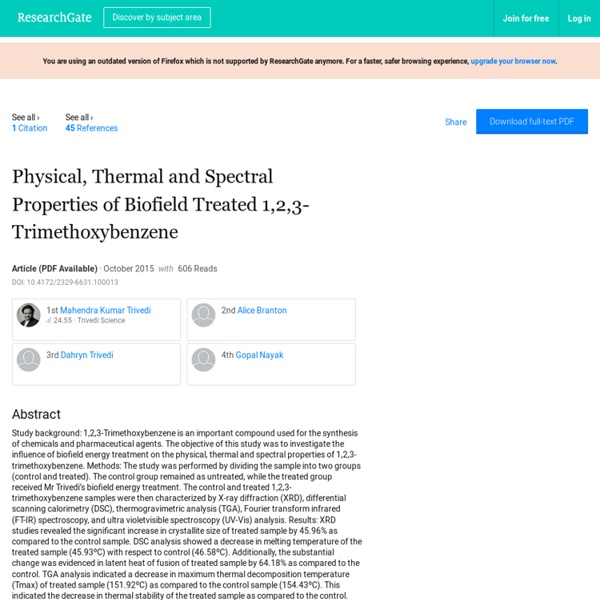Physical, Thermal and Spectral Properties of Biofield Treated 1,2,3-Trimethoxybenzene
Abstract Study background: 1,2,3-Trimethoxybenzene is an important compound used for the synthesis of chemicals and pharmaceutical agents. The objective of this study was to investigate the influence of biofield energy treatment on the physical, thermal and spectral properties of 1,2,3-trimethoxybenzene. Methods: The study was performed by dividing the sample into two groups (control and treated). The control group remained as untreated, while the treated group received Mr Trivedi’s biofield energy treatment. Tables at a glance Figures at a glance
Biofield and its Effect on 1,2,3-Trimethoxybenzene | Bepress
Description Study background: 1,2,3-Trimethoxybenzene is an important compound used for the synthesis of chemicals and pharmaceutical agents. The objective of this study was to investigate the influence of biofield energy treatment on the physical, thermal and spectral properties of 1,2,3-trimethoxybenzene. Methods: The study was performed by dividing the sample into two groups (control and treated). The control group remained as untreated, while the treated group received Mr Trivedi’s biofield energy treatment. Citation Information Trivedi MK, Tallapragada RM, Branton A, Trivedi D, Nayak G, et al. (2015) Physical, Thermal and Spectral Properties of Biofield Treated 1,2,3-Trimethoxybenzene.
Physical, Thermal and Spectral Properties of Biofield Treated 1,2,3-Trimethoxybenzene
Study background: 1,2,3-Trimethoxybenzene is an important compound used for the synthesis of chemicals and pharmaceutical agents. The objective of this study was to investigate the influence of biofield energy treatment on the physical, thermal and spectral properties of 1,2,3-trimethoxybenzene. Methods: The study was performed by dividing the sample into two groups (control and treated). The control group remained as untreated, while the treated group received Mr Trivedi’s biofield energy treatment. The control and treated 1,2,3-trimethoxybenzene samples were then characterized by X-ray diffraction (XRD), differential scanning calorimetry (DSC), thermogravimetric analysis (TGA), Fourier transform infrared (FT-IR) spectroscopy, and ultra violetvisible spectroscopy (UV-Vis) analysis. Results: XRD studies revealed the significant increase in crystallite size of treated sample by 45.96% as compared to the control sample.
Mahendra Kumar Trivedi | Biography
Mahendra Kumar Trivedi completed his Bachelor’s degree in Mechanical Engineering in 1985 and worked as an Engineer for 10 years. In 1995, Mr. Trivedi discovered that he has the unique ability to harness the energy from the universe and transmit it to anywhere on earth, infusing it into living organisms and nonliving materials to optimize their potential. With this ability, Mr. Trivedi is a natural healer.
Physical, Thermal and Spectral Properties of Biofield Treated 1,2,3-Trimethoxybenzene | Mahendra kumar Trivedi
Study background: 1,2,3-Trimethoxybenzene is an important compound used for the synthesis of chemicals and pharmaceutical agents. The objective of this study was to investigate the influence of biofield energy treatment on the physical, thermal and spectral properties of 1,2,3-trimethoxybenzene. Methods: The study was performed by dividing the sample into two groups (control and treated). The control group remained as untreated, while the treated group received Mr Trivedi’s biofield energy treatment. The control and treated 1,2,3-trimethoxybenzene samples were then characterized by X-ray diffraction (XRD), differential scanning calorimetry (DSC), thermogravimetric analysis (TGA), Fourier transform infrared (FT-IR) spectroscopy, and ultra violetvisible spectroscopy (UV-Vis) analysis. Results: XRD studies revealed the significant increase in crystallite size of treated sample by 45.96% as compared to the control sample.
Effect of external energy on atomic, crystalline and powder characteristics of antimony and bismuth powders
Article First Online: Received: Revised: DOI: 10.1007/s12034-009-0070-4 Cite this article as: Dabhade, V.V., Tallapragada, R.M.R. & Trivedi, M.K. Abstract Next to atoms and molecules the powders are the smallest state of matter available in high purities and large quantities. To be able to understand the reasons for these changes the powders are characterized by techniques such as X-ray diffraction (XRD), surface area determination (BET), thermal analytical techniques such as DTA-DTG, DSC-TGA and SDTA and scanning electron microscopy (SEM). The treated powder samples exhibited remarkable changes in the powder characteristics at all structural levels starting from polycrystalline particles, through single crystal to atoms. Keywords Antimony bismuth external energy powder Copyright information © Indian Academy of Sciences 2009 Authors and Affiliations Vikram V.
An Open Access Journal of Developing Drugs | Omicsgroup
Mahendra Kumar Trivedi1, Rama Mohan Tallapragada1, Alice Branton1, Dahryn Trivedi1, Gopal Nayak2, Rakesh Kumar Mishra2 and Snehasis Jana2* 1Trivedi Global Inc., 10624 S Eastern Avenue Suite A-969, Henderson, NV 89052, USA 2Trivedi Science Research Laboratory Pvt. *Corresponding Author: Snehasis Jana Trivedi Science Research Laboratory Pvt. Received date: August 13, 2015; Accepted date: August 24, 2015; Published date August 28, 2015 Citation: Trivedi MK, Tallapragada RM, Branton A, Trivedi D, Nayak G, et al. (2015) Characterization of Physical, Thermal and Spectral Properties of Biofield Treated 2, 6-Diaminopyridine. Copyright: © 2015 Trivedi MK, et al. Visit for more related articles at Journal of Developing Drugs Abstract 2, 6-Diaminopyridine (2, 6-DAP) has extensive use in synthesis of pharmaceutical compounds. Keywords Abbreviation Introduction Diaminopyridine are important class of organic compounds, mostly used for synthesis of dyes, cosmetics, drugs and explosives. Materials and Methods
Publication meta - Physical, Thermal and Spectral Properties of Biofield Treated 1,2,3 Trimethoxybenzene
Study background: 1,2,3-Trimethoxybenzene is an important compound used for the synthesis of chemicals and pharmaceutical agents. The objective of this study was to investigate the influence of biofield energy treatment on the physical, thermal and spectral properties of 1,2,3-trimethoxybenzene. Methods: The study was performed by dividing the sample into two groups (control and treated). The control group remained as untreated, while the treated group received Mr Trivedi’s biofield energy treatment. The control and treated 1,2,3-trimethoxybenzene samples were then characterized by X-ray diffraction (XRD), differential scanning calorimetry (DSC), thermogravimetric analysis (TGA), Fourier transform infrared (FT-IR) spectroscopy, and ultra violetvisible spectroscopy (UV-Vis) analysis.



